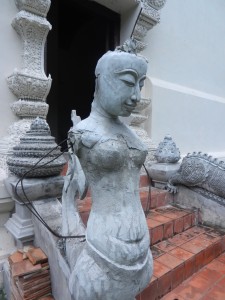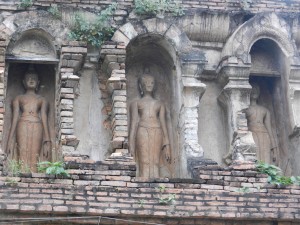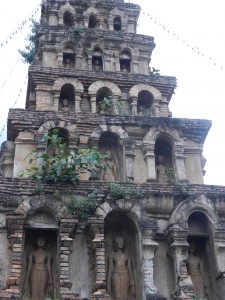This sure doesn’t look like an elephant. We’ll leave the big animal in France and explore something much more graceful.
While France’s King Francois I, imported the Italian Renaissance in the early 16th century to beef up his image, Thais perfected their own art forms. These works expressed a different way of seeing the world than what Westerners are used to. Many Westerners who go to Thailand decide that they’ll never leave, so explore this temple at your own risk.
As Europe’s meaty kings were projecting the images of their courts to govern their growing cities and states, the northern Thai kingdom of Lan Na created art forms that stress graceful energy flows, rather than massive bodies and straight lines that control your gaze.
All the pictures in this post are of a wat in Nan called Wat Phaya Wat. Statues that welcome you to the vihara (public assembly hall) have forms as graceful and sinuous as the Sukhothai Buddha. But an even cooler thing is–
–the forms of many things flow together. The statue and the small shrine in the above shot complement each other. Their lilting surfaces seem to project graceful energies that blend, and they tame nature’s abundance in the background. Stroll a bit, and–
The shrines’ forms slowly shift so that their energies seem to mesh even more. I thus felt embraced by soft energies.
The tall building is the stupa, and its thin pyramidal shape came from a kingdom called Haripunchai. It thrived before Lan Na took it over in the late 13th century. Builders of several northern Thai wats’ stupas incorporated this form.
The stupa has five levels of niches (three on each side). Each holds a slender Buddha statue.
All the statues bestow grace on the whole temple compound–on all its art forms, natural scenery and worshipers.
Francois I can have his hulking elephant. The more you wander around a Thai temple’s light forms, the more beauty you’ll find. We’ll explore more of Wat Phaya Wat in the next post, and we’ll find that the little things can be even more enchanting.







Comments on this entry are closed.